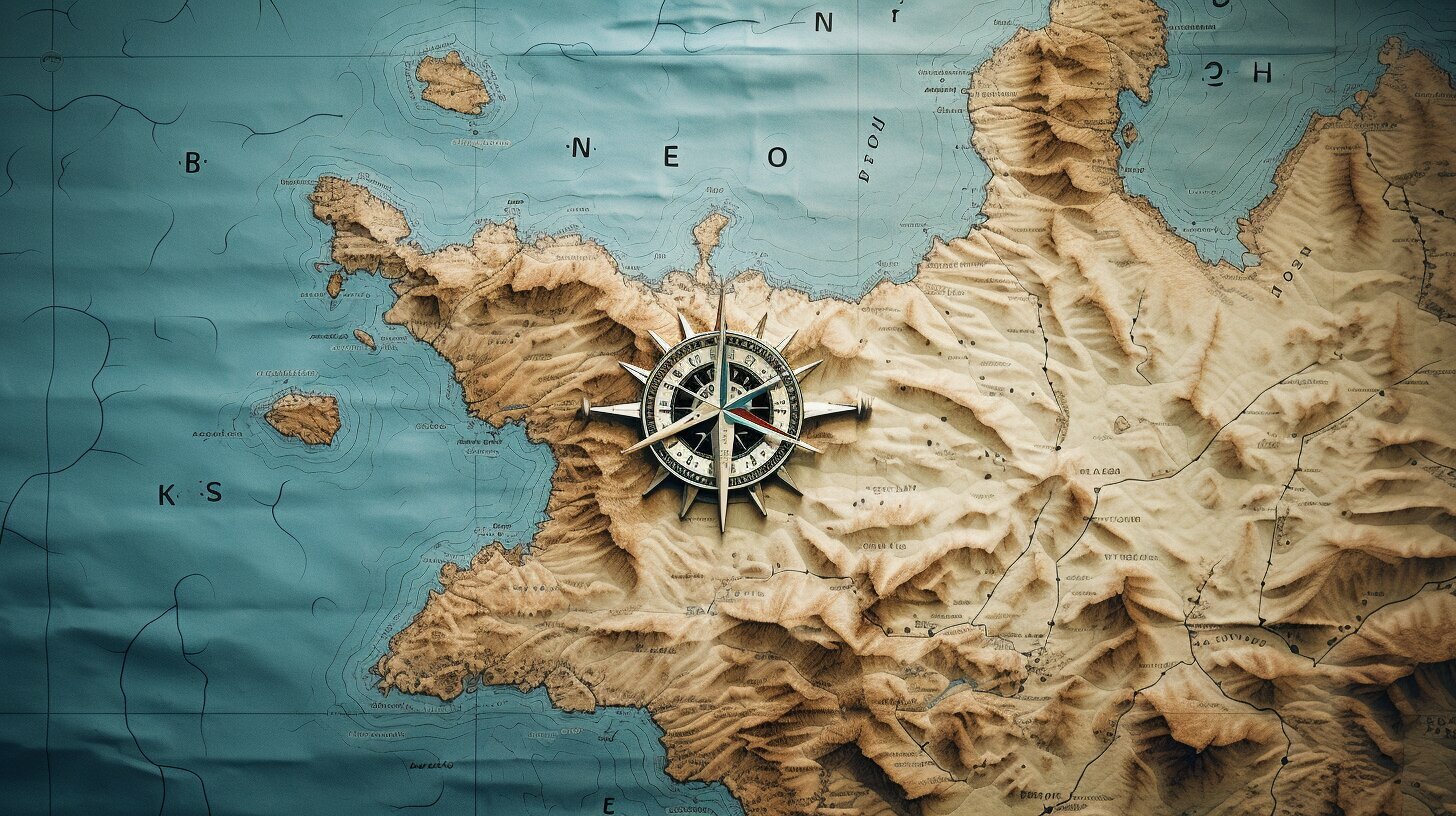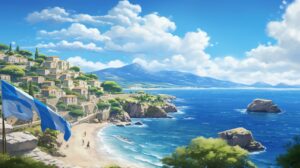What country is Hawaii in?
Hawaii is located in the Pacific Ocean and is part of the United States. It is the 50th state of the United States and is not its own country. Hawaii consists of eight main islands and is the most isolated populated landmass in the world. It has a unique history, with its discovery by Captain James Cook in 1778 and subsequent interactions with various foreign powers. Hawaii was formally annexed by the United States in 1898.
Key Takeaways:
- Hawaii is part of the United States, not a separate country.
- Hawaii consists of eight main islands.
- It is the most isolated populated landmass in the world.
- Captain James Cook discovered Hawaii in 1778.
- The United States formally annexed Hawaii in 1898.
Hawaii’s Geography and Location
Located in the Pacific Ocean, Hawaii’s geographical position sets it apart as an incredibly unique destination. Comprised of eight main islands, Hawaii is known for its stunning natural landscapes, volcanic activity, and warm tropical climate. Each island offers its own distinct charm, making it a diverse and captivating place to explore.
The main Hawaiian Islands are: Hawaii (also known as the Big Island), Maui, Oahu, Kauai, Molokai, Lanai, Niihau, and Kahoolawe. These islands are spread across approximately 1,500 miles in the Pacific Ocean, making Hawaii the most isolated inhabited landmass on Earth.
The geographical features of Hawaii are exceptionally diverse. From the active volcanoes of Hawaii Island to the lush rainforests of Kauai, and the iconic beaches of Maui and Oahu, this archipelago offers something for everyone. Visitors can experience everything from hiking along breathtaking coastal cliffs to snorkeling in vibrant coral reefs.
Moreover, Hawaii’s geographical position makes it a strategic location in the Pacific. It serves as a vital hub for international travel and trade, with its proximity to Asia and the Americas. This unique location has also contributed to the rich cultural heritage of the islands, resulting in a vibrant blend of influences from Polynesia, Asia, Europe, and the Americas.
| Island | Area (sq miles) | Population |
|---|---|---|
| Hawaii (Big Island) | 4,028 | 200,381 |
| Maui | 727 | 167,207 |
| Oahu | 597 | 953,207 |
| Kauai | 562 | 72,293 |
| Molokai | 260 | 7,345 |
| Lanai | 141 | 3,102 |
| Niihau | 69 | 170 |
| Kahoolawe | 45 | Uninhabited |
Hawaii’s Relationship with the United States
Hawaii is not its own country, but rather a state within the United States. As the 50th state, it holds a unique status, both geographically and politically. Located in the Pacific Ocean, Hawaii consists of eight main islands and is the most isolated populated landmass in the world. Its relationship with the United States has shaped its history and culture, blending American influences with its rich indigenous heritage.
From its discovery by Captain James Cook in 1778, Hawaii has had encounters with various foreign powers. However, it was in 1898 that Hawaii was formally annexed by the United States, becoming an integral part of the nation. This annexation has had far-reaching implications for the state, solidifying its status as part of the United States and bringing it under American governance.
Today, Hawaii’s relationship with the United States continues to evolve and thrive. With its own state government and representation in the federal system, Hawaii retains a sense of autonomy while benefiting from the resources and opportunities provided by its connection to the United States. This unique relationship has contributed to the growth and development of Hawaii as a vibrant and culturally diverse state.
In conclusion, Hawaii is not an independent country, but a state within the United States. Its geography, history, and political ties with the United States have shaped its identity, making it a unique and fascinating destination that attracts visitors from all over the world.
Table: Hawaii’s Relationship with the United States
| Year | Event |
|---|---|
| 1778 | Captain James Cook discovers Hawaii |
| 1898 | Hawaii is formally annexed by the United States |
| 1959 | Hawaii becomes the 50th state of the United States |
The Discovery of Hawaii
Hawaii’s history traces back to its discovery by Captain James Cook in 1778. This marked the first documented encounter between the indigenous people of Hawaii and European explorers. Cook, a British explorer, arrived on the island of Kauai during his third and final voyage across the Pacific Ocean.
Upon his arrival, Cook was met with curiosity and hospitality by the native Hawaiians. He named the islands the “Sandwich Islands” in honor of the Earl of Sandwich. Cook’s exploration and subsequent contact with Hawaii opened up a new chapter in the islands’ history, as it attracted attention from other foreign powers.
The discovery of Hawaii by Captain Cook set the stage for a series of interactions between the native Hawaiians and European explorers, missionaries, traders, and eventually the United States. These encounters would shape the cultural, political, and economic landscape of the islands in the years to come.
| Year | Event |
|---|---|
| 1778 | Captain James Cook’s discovery of Hawaii |
| 1820s | Missionaries arrive from the United States |
| 1840 | Hawaii establishes a formal government |
| 1893 | Overthrow of the Hawaiian monarchy |
| 1898 | Annexation of Hawaii by the United States |
Annexation of Hawaii
Hawaii was formally annexed by the United States in 1898, solidifying its place within the country. This pivotal moment in Hawaii’s history came after a series of interactions with foreign powers and the influence of Captain James Cook’s discovery of the islands in 1778. The annexation marked the end of Hawaii’s status as an independent nation and the beginning of its integration into the United States.
The decision to annex Hawaii was largely driven by economic and strategic interests. The islands’ fertile lands and ideal climate made them valuable for agricultural purposes, particularly the cultivation of sugarcane and pineapple. Additionally, Hawaii’s strategic location in the Pacific Ocean made it an important stopover point for ships traveling between Asia and the Americas.
The formal annexation of Hawaii was not without controversy, as it led to protests and resistance from the native Hawaiian population. Many Hawaiians opposed the loss of their sovereignty and the impact of American influence on their culture. Today, the legacy of annexation is still felt in debates surrounding the rights and autonomy of indigenous Hawaiians.
The Annexation of Hawaii in Numbers
| Year | Event |
|---|---|
| 1778 | Captain James Cook discovers the Hawaiian Islands |
| 1893 | Queen Liliuokalani’s monarchy is overthrown by a group of American businessmen |
| 1898 | Hawaii is formally annexed by the United States |
| 1959 | Hawaii becomes the 50th state of the United States |
Despite the controversies surrounding its annexation, Hawaii’s integration into the United States has brought both benefits and challenges. Today, Hawaii stands as a unique state with a vibrant culture and diverse population. Its geographical isolation and stunning natural beauty continue to make it a popular tourist destination and a place of global significance.
The Islands of Hawaii
Hawaii consists of eight main islands, each offering its own distinct charm and beauty. From the stunning beaches of Oahu to the lush landscapes of Kauai, these islands are a true paradise in the Pacific Ocean. Let’s take a closer look at each island and what makes them unique.
Oahu
Oahu, often referred to as “The Gathering Place,” is home to the state capital, Honolulu. This bustling island offers a mix of stunning beaches, vibrant city life, and historical sites such as the Pearl Harbor National Memorial. It’s also known for its iconic surf spots like Waikiki Beach.
Maui
Known as the “Valley Isle,” Maui is famous for its breathtaking landscapes, including the lush Iao Valley and the stunning sunrise at Haleakala National Park. Visitors can relax on the beautiful beaches of Kaanapali or explore the picturesque town of Lahaina, filled with charming shops and restaurants.
Kauai
Kauai, often called the “Garden Isle,” boasts dramatic cliffs, lush rainforests, and cascading waterfalls. It’s a nature lover’s paradise, with attractions like the Na Pali Coast and Waimea Canyon offering stunning vistas. Adventure seekers can also enjoy activities like hiking, kayaking, and zip-lining.
Hawaii (Big Island)
The largest island in the archipelago, the “Big Island” is known for its diverse landscapes. From the snow-capped peaks of Mauna Kea to the active Kilauea volcano, there’s no shortage of natural wonders. Visitors can also explore historic sites like Pu’uhonua o Honaunau National Historical Park and snorkel in the crystal-clear waters of Kealakekua Bay.
The remaining islands of Molokai, Lanai, Niihau, and Kahoolawe offer their own unique experiences, from the rugged beauty of Molokai’s Kalaupapa National Historical Park to the secluded luxury of Lanai’s resorts. Each island has its own character, making Hawaii a truly diverse destination for travelers.
| Island | Nickname | Main Attractions |
|---|---|---|
| Oahu | The Gathering Place | Waikiki Beach, Pearl Harbor National Memorial |
| Maui | The Valley Isle | Haleakala National Park, Kaanapali Beach |
| Kauai | The Garden Isle | Na Pali Coast, Waimea Canyon |
| Hawaii (Big Island) | The Big Island | Mauna Kea, Kilauea Volcano |
“Hawaii’s islands offer a diverse range of experiences, from bustling city life to untouched natural beauty. Whether you’re seeking adventure, relaxation, or cultural immersion, there’s an island in Hawaii that will capture your heart.”
Hawaii’s Unique Culture
Hawaii’s unique location has shaped its vibrant and diverse cultural landscape. Situated in the heart of the Pacific Ocean, the islands of Hawaii have been influenced by various cultures from around the world, creating a rich tapestry of traditions, customs, and art forms.
The Hawaiian culture, with its strong emphasis on community and respect for nature, is deeply rooted in the land and sea. Traditional practices such as hula dancing, lei making, and outrigger canoe paddling are cherished and passed down through generations, reflecting the deep connection between the people and their environment.
The blending of native Hawaiian traditions with influences from Asia, Europe, and America has resulted in a truly unique cultural fusion. The cuisine of Hawaii, for example, showcases a harmonious blend of flavors from different culinary traditions, including Japanese, Filipino, Portuguese, and Polynesian.
| Key aspects of Hawaiian culture: | Impact of Hawaii’s geographical location: |
|---|---|
| – Hula and traditional dance forms | – Influence from Pacific island cultures |
| – Lei making and flower crafts | – Interaction with Asian and American cultures |
| – Aloha spirit and hospitality | – Blend of flavors in Hawaiian cuisine |
| – Traditional music and instruments | – Integration of nature and spirituality |
Visitors to Hawaii are often captivated by the warmth and openness of the local people, who embody the spirit of aloha. This sense of hospitality and inclusiveness is deeply ingrained in the Hawaiian culture, making it a welcoming and inviting destination for travelers from all over the world.
The Beauty of Hawaiian Art
Hawaii’s unique cultural heritage is also expressed through its art forms. From intricate wood carvings to vibrant paintings and delicate flower arrangements, Hawaiian art reflects the island’s natural beauty and the creativity of its people.
- The art of hula is a captivating dance form that tells stories through graceful movements and expressive gestures. It is a blend of dance, music, and poetry, showcasing the deep connection between the Hawaiian people and their environment.
- Hawaiian quilts, known for their intricate patterns and vibrant colors, are a testament to the artistic skills passed down through generations. Each quilt tells a story and is a cherished heirloom that represents the culture and history of Hawaii.
- Traditional Hawaiian tattoos, known as “kakau,” are another form of artistic expression that holds deep cultural significance. These tattoos often depict symbols of nature, ancestry, and personal identity, connecting the individual to their Hawaiian roots.
“Hawaii is not just a place; it’s a way of life. The beauty of the islands and the richness of their culture inspire artists from all walks of life.” – Anonymous
Through its vibrant and diverse cultural landscape, Hawaii offers a unique and enriching experience for both residents and visitors. The blending of traditions and influences from different cultures has created a vibrant tapestry of art, music, dance, and culinary delights that make Hawaii truly one-of-a-kind.
| Art forms in Hawaii: | Significance of Hawaiian art: |
|---|---|
| – Hula | – Preserving and sharing cultural traditions |
| – Hawaiian quilts | – Reflecting the island’s natural beauty |
| – Traditional tattoos | – Connecting individuals to their Hawaiian roots |
Hawaii’s Global Significance
Hawaii’s global significance extends beyond its status as a state and stems from its strategic position in the Pacific and its allure as a renowned tourist destination. Situated in the middle of the vast Pacific Ocean, Hawaii serves as a crucial link between the United States and Asia, acting as a major hub for international trade and travel. Its geographical position allows for easy access to both North America and the Asia-Pacific region, making it an ideal gateway for global commerce and cultural exchange.
As one of the most isolated populated landmasses in the world, Hawaii’s unique location has shaped its history and culture. Its remote setting has resulted in a distinct blend of influences from Polynesia, Asia, Europe, and the Americas, creating a vibrant and diverse society that is celebrated worldwide. From the rich traditions of hula and ukulele music to its world-famous cuisine, Hawaii’s cultural contributions resonate far beyond its shores.
Furthermore, Hawaii’s natural beauty and idyllic climate have made it a magnet for tourists from around the globe. Its stunning landscapes, including pristine beaches, lush rainforests, and majestic volcanoes, provide endless opportunities for outdoor adventures and unparalleled experiences. Whether visitors are seeking relaxation on the sun-kissed shores or seeking thrills in the crystal-clear waters, Hawaii offers a paradise that captivates and rejuvenates.
Ultimately, Hawaii’s global significance lies not only in its geographical position but also in its ability to bridge continents, cultures, and hearts. It represents a unique meeting point of East and West, where the spirit of aloha welcomes all who visit. As the enchanting islands continue to captivate the world, Hawaii remains a symbol of harmony, resilience, and unparalleled beauty.
FAQ
Q: What country is Hawaii in?
A: Hawaii is part of the United States, making it the 50th state of the country. It is not its own separate country.
Q: Where is Hawaii located?
A: Hawaii is located in the Pacific Ocean. It is the most isolated populated landmass in the world.
Q: How did Hawaii become part of the United States?
A: Hawaii was formally annexed by the United States in 1898.
Q: Who discovered Hawaii?
A: Hawaii was discovered by Captain James Cook in 1778.
Q: How many islands make up Hawaii?
A: Hawaii consists of eight main islands.
Q: What is unique about Hawaii’s culture?
A: Hawaii has a rich and diverse cultural heritage influenced by its geographical location and historical background.
Q: How significant is Hawaii globally?
A: Hawaii holds global significance due to its strategic location in the Pacific and its popularity as a tourist destination.
Source Links
- https://travelcompositions.com/is-hawaii-a-country/
- https://history.state.gov/countries/hawaii
- https://en.wikipedia.org/wiki/Hawaii



